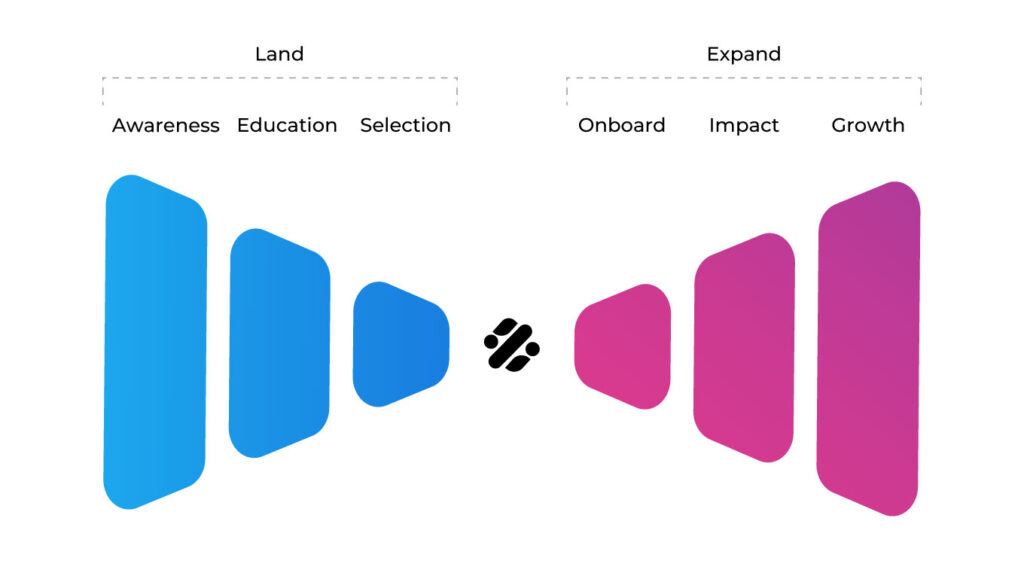Many companies will state that the customer journey is an important part of their business. And that customer retention is one of their goals. However, not every company has a clear layout to help them keep track of metrics.
And they end up with results they don’t know how to control or improve. This can lead to high customer churn or dwindling leads. If the company doesn’t know how to address these issues, it can rapidly lead to disaster.
What is the Bowtie Funnel?
Bowtie Funnels give a complete view of the customer journey, from the first interaction all the way to loyalty and advocacy.
Unlike traditional funnels, which often stop at the point of sale, Bowtie Funnels capture post-purchase stages, showing how businesses can drive not just new sales but also customer retention and growth.
This model has been set up to do multiple things:
- Track the whole customer lifecycle, from the very first interaction to the stage where the customer becomes a loyal advocate for the brand.
- Highlight post-purchase opportunities, with a focus on renewals, upsells, and referrals.
- Optimize customer retention by reducing customer churn and increasing customer lifetime value (CLTV).
Using the Bowtie Funnel, you can move from a transactional model to a relationship-driven one. The goal will shift from ‘making the sale’ to nurturing your customers over time and focusing on their experience.
Example(s) of a Bowtie Funnel
The structure of the Bowtie Funnel is broadly useful across sectors. It connects the classic marketing funnels with the newer customer retaining strategies.
This allows you to not only convert prospects into customers but also keep those customers happy and engaged.
Retail Example
A clothing brand may first convert a customer via an online advertisement. After the purchase, they engage the customer with subsequent emails, loyalty rewards, and personalized product recommendations.
By nurturing this relationship, they increase repeat purchases and encourage word-of-mouth referrals.
SaaS Example
Subscription-based businesses use Bowtie Funnels to track customer behavior post-signup. For example, you can monitor user activity to provide timely upgrades, renewal incentives, and support. This strategy ensures customer satisfaction and reduces churn.
Deconstructing the Bowtie
The bowtie model offers a comprehensive view of the customer journey, by bringing together the pre-purchase and post-purchase actions. And this creates a full map of the customer journey.

Left side of the bowtie funnel
- Awareness: This stage is all about capturing the attention of potential customers who might be unaware of your brand or product. Here, you can use strategies revolving around content marketing, social media marketing, and search engine optimization (SEO). By creating informative and engaging content, you can increase brand awareness and position yourself as a knowledgeable player in the market.
- Education: Once your prospects are aware, you can educate them about the problem you solve and show them how your product or service is the perfect fit. This is where you bring in the detailed case studies, webinars, and free trials.
- Selection: Now that your potential customers have the knowledge, it is time for the selection phase. To win them over, provide them with compelling product demos, clear pricing structures, and testimonials from other happy clients.
Right side of the bowtie funnel
- Onboard: After you have made the sale, the story isn’t over. It has just begun. You must provide the customer with a smooth onboarding and make sure they understand how to use the product. In short, you need to set them up for success.
- Impact: With the help of your customer success team, focus on ensuring customers achieve maximum results. This can be done through personalized training or proactive support to help customers maximize the value they receive.
- Growth: Happy customers become loyal customers. In the growth phase, you can leverage upsells, cross-sells, and loyalty programs to encourage repeat business and grow the potential of your customer base. By nurturing these relationships, you create brand advocates who will be your informal salespeople.
How to Optimize the Bowtie Funnel
Optimizing the bowtie funnel for your use case could boost your profits by focusing on key customer touchpoints. You can increase customer engagement and overall efficiency by leveraging the data you gather and incorporating customer feedback into your decision-making process.
Also, good cross-team communication helps you keep consistent messaging which will create a more pleasant experience for your customers and make them stick around for longer.
Identify Key Touchpoints
Begin with a complete map of every interaction a customer has with your business. These can be a website visit, a customer service call, or an email, among others.
Now, look at the points that matter most for your customers. Focus on the critical points where the customers need to make decisions. These will be the most important ones to focus on in the beginning.
To keep track of everything, use tools like Miro to visualize the customer journey. Once you have it all mapped out, you can easily spot any areas that need attention.
Utilize Data Analytics
Collecting data and analyzing customer behavior is key. If the mapped-out customer journey tells you how customers behave, this will give you insights into why they act that way.
Data-driven companies are 23 times more likely to acquire customers and six times more likely to retain them. So, it is important to look for purchase patterns, website interactions, net promoter scores, drop-off points, etc.
To leverage this, use analytics tools that connect with your CRM. Also, look for tools that can show you heatmaps or session recordings. A good (and free) tool for this is Microsoft Clarity.
Using Performance Metrics and KPIs
Measuring the right metrics is vital. These could be conversion rates, customer lifetime values, or retention rates. Reviewing these figures regularly helps identify what seems to be working.
Numbers help spot trends and pinpoint places needing work. If trying to optimize a process, focus on improving the numbers that affect your goals the most.
Review your metrics and KPIs frequently. They can show areas that need improvement and let you stay ahead and adapt quickly.
Regular Feedback
You can collect feedback from your customers in 2 ways: by asking them or by analyzing their behavior.
And this has a double role in your business. Firstly, 77% of customers see brands more favorably if they proactively seek and apply their feedback. And secondly, you will be able to improve the product or service that you offer.
So, ask your customers for feedback every time you get the opportunity. But also, analyze their behavior as they navigate through the bowtie funnel.
Try to see where they get stuck, what the drop-off points are, which part of your software is confusing, etc.
Cross-functional Teams
We all know the memes about the relationship between sales and marketing. And in most cases, they are true. Why? Because they don’t have a good way of collaborating and working together.
If you implement the bowtie funnel in your business, they will have no other choice. Because it includes all aspects of the commercial teams, they need to work together.
To encourage this collaboration, you can schedule regular meetings between key people in marketing, sales, and customer success to go over the metrics and KPIs along the funnel.
Conclusion
The Bowtie Funnel is a complete model for customer relationships that connects acquisition and retention.
It puts customers at the center of the business. It encompasses all the touchpoints that a customer has with a business, whether pre-sale, during the sale, or after the sale.
The strength of this approach is its ability to convert standard transactions into growth opportunities. And keeping the balance between the metrics doesn’t mean you are just filling a leaky bucket. You are building relationships that last and bring real value to your bottom line.


